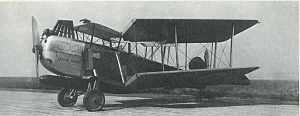Levasseur PL.2
| Levasseur PL.2 | |
|---|---|
 | |
| Levasseur PL.2, June 1926 | |
| Role | Torpedo-bomber biplane |
| Manufacturer | Levasseur |
| Designer | Pierre Levasseur |
| First flight | 1922 |
| Introduction | 1926 |
| Retired | 1932 |
| Primary user | French Navy |
| Produced | 1922-1923 |
| Number built | 11 |
|
| |
The Levasseur PL.2 was a French biplane torpedo bomber designed by Pierre Levasseur for the French Navy.
Design and development
The second design of Pierre Levasseur was the PL.2 a single-seat unequal-span biplane inspired by designs from Blackburn Aircraft. It had a fixed tailskid landing gear and was powered by a nose-mounted Renault engine. The first of two prototypes first flew in November 1922, the second aircraft had a four-bladed propeller and other powerplant improvements. Nine production aircraft were built in 1923, these were fitted with ballonets and jettisonable landing gear for operations at sea.[1]
Operational history
The aircraft entered service in 1926 aboard the French carrier Béarn and continued in use until they were scrapped in 1932.
Variants
- PL 2.01 : First torpedo-bomber prototype.
- PL 2.02 : Second prototype, equipped with a four-blade propeller.
- PL.2 : Single-seat torpedo-bomber aircraft, nine built for the French Navy.
Operators
- French Navy
- Escadrille 7B2
Specifications
Data from The Illustrated Encyclopedia of Aircraft[2]
General characteristics
- Crew: 1
- Length: 14.9 m (49 ft 8.50 in)
- Wingspan: 15.15 m (49 ft 8½ in)
- Height: 3.9 m (13 ft 3.25 in)
- Gross weight: 3,653 kg (8,053 lb)
- Powerplant: 1 × Renault 12Ma, 433 kW (580 hp) each
Performance
- Maximum speed: 180 km/h (112 mph)
- Range: 700 km (435 miles)
- Service ceiling: 2454 m (8,052 ft)
Armament
- 1 x 7.7 mm (0.303 in) machine-gun
- 450Kg (992lb) Torpedo or bombs
References
Notes
Bibliography
| Wikimedia Commons has media related to Levasseur PL.2. |
- Taylor, John W. R. and Jean Alexander. Combat Aircraft of the World. New York: G.P. Putnam's Sons, 1969. ISBN 0-71810-564-8.
- Taylor, Michael J. H. Jane's Encyclopedia of Aviation. London: Studio Editions, 1989. ISBN 0-517-69186-8.
| ||||||||||||||||||||||